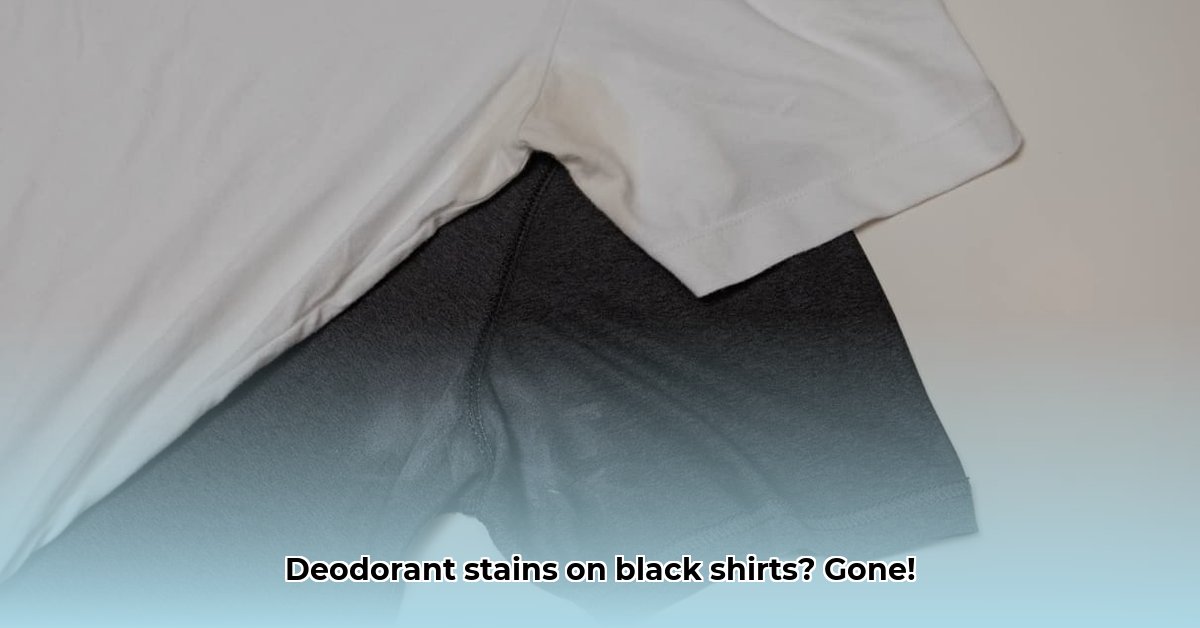Deodorant stains on your favorite black shirt? Don’t let them ruin your day! This guide is your secret weapon, offering proven DIY methods and prevention tips to keep your black wardrobe looking its best. Whether the stain is fresh or stubbornly set-in, we’ve got the solution.
Quick Fixes: Fresh Deodorant Smudges
Just noticed a white streak? Act fast! These quick fixes likely will save your shirt:
- Fabric-on-Fabric: Rub the fabric against itself (or a nylon stocking). The friction can dislodge fresh deodorant.
- Dryer Sheet Magic: A used dryer sheet can gently lift away the residue.
- Foam Rubber Eraser: Use the foam from a dry cleaning hanger to lightly buff the mark.
Demonstrating the dryer sheet method.
(Please replace this with an actual image demonstrating this technique)
Tackling Set-In Stains: DIY Remedies
For more stubborn stains, these pantry staples can come to the rescue:
The Baking Soda Paste Method
- Mix: Combine baking soda and water to form a toothpaste-like paste.
- Apply: Spread the paste evenly over the stain.
- Wait: Let it sit for several hours or overnight.
- Rinse: Rinse thoroughly with cool water.
Why it might work: Baking soda’s mild abrasiveness lifts the stain, while its deodorizing properties freshen the fabric.
(Placeholder image – replace with actual image)
The Vinegar Solution
- Mix: Combine equal parts white vinegar and water.
- Soak: Submerge the stained area in the solution.
- Wait: Let it soak for 30-60 minutes.
- Rub: Gently rub the stain.
- Rinse: Rinse thoroughly with cool water.
Why it might work: Vinegar’s acidity may break down deodorant components, loosening their hold on the fabric. However, some debate exists on its impact on certain fabrics, so test cautiously.
(Placeholder image – replace with actual image)
The Hydrogen Peroxide & Dish Soap Duo
- Spray: Spritz the stain with 3% hydrogen peroxide.
- Add Soap: Apply a few drops of dish soap.
- Scrub: Gently scrub with a soft brush.
- Wait: Let it sit for 30 minutes.
- Wash: Launder as usual.
Why it might work: Hydrogen peroxide’s oxidizing power and dish soap’s grease-cutting action combine forces for a potent clean. Caution: Hydrogen peroxide can bleach some fabrics; always test first.
(Placeholder image – replace with actual image)
Oxygen Bleach Soak (For Extreme Cases)
For truly tenacious stains, an oxygen bleach soak might be necessary. Always follow product instructions and test on a hidden area first, as some fabrics may react negatively. Ongoing research suggests gentler formulations are being developed, so explore current product options if concerned about fabric damage.
Prevention: Your Proactive Strategy
Avoid stains altogether with these simple steps:
- Smart Choices: Gel deodorants are often less likely to leave marks than solids. Aluminum-free options might also reduce staining.
- Patience is Key: Allow deodorant to dry completely before dressing.
- Less is More: Apply a thin, even layer—excess deodorant increases staining potential.
Troubleshooting
- Delicates: Treat delicate fabrics (silk, lace) with extra care. Test any cleaning method on a hidden area first, or consult a professional cleaner.
- Stubborn Stains, Round Two: Repeat the cleaning process if needed. Sometimes, a combination of methods is most effective.
Choosing the Right Deodorant
Deodorant ingredients can impact staining. Aluminum, talc, and heavy fragrances are common culprits. Look for deodorants labeled “invisible,” “clear,” or formulated for dark fabrics.
Stain Removal Summary Table
| Method | Pros | Cons | Best For |
|---|---|---|---|
| Fabric-on-Fabric | Quick, no products needed | Only effective on fresh stains | Fresh stains |
| Dryer Sheet | Convenient, readily available | May leave residue, not effective on all deodorants | Fresh stains |
| Foam Rubber | Gentle on fabric | May require multiple attempts | Fresh stains |
| Baking Soda Paste | Natural, inexpensive, deodorizing | Can be abrasive, requires time | Set-in stains |
| Vinegar Solution | Inexpensive, readily available | May damage some fabrics, strong smell | Set-in stains |
| Hydrogen Peroxide & Dish Soap | Effective on tough stains | May bleach some fabrics, multiple steps required | Set-in stains |
| Oxygen Bleach | Effective on stubborn stains | Can damage some fabrics, use with caution | Very stubborn set-in stains |
Why Are Deodorant Stains So Noticeable on Black?
The white residue, often composed of aluminum compounds, creates a stark contrast against dark fabric. The texture of black clothing, especially cotton, can also trap more residue, exacerbating the problem.
Conclusion
Don’t let deodorant stains win! With these tips and techniques, you can confidently rock your black wardrobe. Remember to choose the method that best suits your situation and always proceed with caution on delicate fabrics. Share your success stories in the comments below!
- How to Remove Water Stains from Fabric: A Complete Guide - April 26, 2025
- How to Get Motor Oil Out of Clothes: Proven Methods & Expert Tips - April 26, 2025
- How to Get Deodorant Out of Black Shirts: Easy Stain Removal Guide - April 26, 2025










